Which are the 7 most famous constellations every man should know? What are the most poular and major of all – explained for dummies. How many of them are there in the Sky? Top 18 most recognizable constellations and the 12 zodiac signs.
In this article, we are exploring the fascinating world of constellations, from their origins and etymology to the mythology and science surrounding them. We’re discussing the different types of constellations, including zodiac constellations, seasonal constellations, and animal constellations, and their significance in various cultures throughout history. Additionally, we’ve looked at the connection between star constellations and zodiac signs and how they relate. Whether you’re interested in astronomy, mythology, or the beauty of the night sky, this article provides a beginner’s guide to exploring the wonders of the universe.
Contents
What are the 7 major constellations (List)
There is no definitive list of „major“ constellations, but the following seven constellations are often considered to be among the most prominent and recognizable in the night sky:
- Ursa Major (the Great Bear or Big Dipper)
- Orion (the Hunter)
- Cassiopeia (the Queen)
- Cygnus (the Swan)
- Leo (the Lion)
- Taurus (the Bull)
- Scorpius (the Scorpion)
Note that the number and selection of „major“ constellations can vary depending on cultural and historical perspectives.
The most famous star constellations for dummies.
- Ursa Major (the Great Bear or Big Dipper): This constellation looks like a big, spoon-shaped object with a long handle. It’s one of the most recognizable constellations often used to find the North Star.
- Orion (the Hunter): This constellation looks like a person with a belt and a sword. It’s often visible in the winter and is named after a mythological hunter.
- Cassiopeia (the Queen): This constellation looks like a „W“ or an „M“ in the sky. It’s named after a queen in Greek mythology.
- Cygnus (the Swan): This constellation resembles a swan with outstretched wings. It’s sometimes called the Northern Cross because of its shape.
- Leo (the Lion): This constellation resembles a lion and is often visible in the spring. It’s named after the Lion from Greek mythology that Hercules was said to have slain.
- Taurus (the Bull): This constellation resembles a bull with horns. It’s often visible in the winter and is named after the Bull from Greek mythology that Zeus turned into a constellation.
- Scorpius (the Scorpion): This constellation resembles a scorpion with a long tail and curved pincers. It’s often visible in the summer and is named after the Scorpion from Greek mythology that Orion was said to have fought.
These constellations are just a few of the many shapes people have seen in the stars over the centuries. They’re a great way to explore the night sky and learn about the stories people have told about the stars for thousands of years.
Valuable Resource (Buy and Reada in Detail!):
What is the origin of their names (Etymology and Mythology)
Sure, here’s a brief overview of the etymology and mythology behind the names of the seven constellations mentioned earlier:
- Ursa Major (the Great Bear or Big Dipper): „Ursa“ is Latin for „bear,“ and „major“ means „greater“ in Latin. In Greek mythology, the constellation represents Callisto, a beautiful nymph turned into a bear by the goddess Hera. Callisto’s son, Arcas, is represented by the smaller constellation Ursa Minor (the Little Bear).
- Orion (the Hunter): Orion was a Greek hunter known for his strength and good looks. He was eventually killed by a scorpion and was placed in the stars as a constellation.
- Cassiopeia (the Queen): Cassiopeia boasted about her beauty. The gods punished her by being tied to a chair and placed in the sky.
- Cygnus (the Swan): „Cygnus“ is Latin for „swan.“ In Greek mythology, the constellation represents Zeus, who turned himself into a swan to seduce Leda, the wife of the Spartan king Tyndareus.
- Leo (the Lion): „Leo“ is Latin for „lion.“ In Greek mythology, the constellation represents the Nemean Lion, a giant lion with impenetrable skin that was eventually slain by the hero Heracles (Hercules in Roman mythology).
- Taurus (the Bull): „Taurus“ is Latin for „bull.“ In Greek mythology, the constellation represents the Bull that Zeus turned himself into to kidnap Europa, a Phoenician princess.
- Scorpius (the ScorpionScorpion): „Scorpius“ is Latin for „scorpion.“ In Greek mythology, the constellation represents the Scorpion that killed the Hunter Orion.
These are just a few examples of the many myths and legends associated with the constellations. The stories behind the constellations have been passed down through generations and have helped people navigate and understand the night sky for thousands of years.
What does the word constellation mean, and where does it come from?
The word „constellation“ comes from the Latin word „constellatio,“ which means „set of stars.“ A constellation is a group of stars perceived to form a pattern or shape in the sky when viewed from Earth. The stars in a constellation may not be physically related or located near each other in space, but they appear close together from our perspective on Earth.
Recognizing and naming constellations dates back thousands of years, and different cultures worldwide have their constellations and associated mythologies. The ancient Greeks and Romans are the most well-known for their constellations and stories about the gods and heroes they represent.
Today, constellations are still used to locate and navigate the stars and for scientific and astronomical study. Eighty-eight officially recognized constellations cover the entire sky, and many more unofficial constellations that different cultures and societies have identified over the centuries.
What types of constellations do we need to know?
Several different types of constellations are essential to know about. Here are a few examples:
- Zodiac constellations: The zodiac constellations are a set of 12 constellations that lie along the ecliptic, which is the apparent path of the Sun through the sky. The zodiac constellations are used in astrology and are associated with the 12 signs.
- Circumpolar constellations: Circumpolar constellations are always visible in the sky, no matter the time of year or time of night. These constellations are located near the celestial pole. It is the point in the sky around which the stars appear to rotate.
- Seasonal constellations: Seasonal constellations are those that are visible during a particular season of the year. For example, Orion is a winter constellation in the Northern Hemisphere, while Scorpius is a summer constellation.
- Mythological constellations: Many constellations are named after characters from mythology, such as Hercules, Cassiopeia, and Perseus. Learning about the fictitious stories associated with these constellations can help deepen our understanding and appreciation of the stars.
- Asterisms: An asterism is a recognizable pattern of stars within a constellation, such as the Big Dipper within Ursa Major. While not technically separate constellations, many asterisms are well-known and valuable for locating other stars and constellations.
These are just a few examples of the types of constellations that are important to know about. Understanding these different categories can help us navigate the night sky and appreciate the beauty and diversity of the stars above us.
More examples of different types of constellations!
Sure, here are some more examples of different types of constellations:
- Modern constellations: The 88 modern constellations were established by the International Astronomical Union (IAU) in the early 20th century. These constellations cover the entire sky and are used for scientific purposes.
- Historical constellations: Many ancient cultures used constellations for navigation or storytelling. These constellations often had different names and were associated with other mythologies or beliefs. Examples include the constellations the Babylonians, Egyptians, and Chinese recognized.
- Planetary constellations: Planetary constellations are groups of stars visible in the same part of the sky as one of the planets in our solar system. For example, the constellation Aquarius is often associated with the planet Uranus.
- Southern Hemisphere constellations: Many of the most recognizable constellations, such as Orion and the Big Dipper, are visible from the Northern Hemisphere. However, the Southern Hemisphere has its own set of prominent constellations, including the Southern Cross, the Magellanic Clouds, and the Centaurus constellation.
- Animal constellations: Many are named after animals, such as the Eagle, the Dolphin, and the Phoenix. These constellations often have shapes that resemble the animals they are called after.
- Celestial objects constellations: Some constellations are named after celestial objects or phenomena, such as the Milky Way, the Northern Lights, and the Aurora Borealis.
Understanding the different types of constellations can help us appreciate the vastness and complexity of the night sky. Whether we are interested in mythology, astronomy, or simply enjoying the beauty of the stars, there is a rich and diverse world of constellations to explore.
The connection between star constellations and zodiac signs
The connection between star constellations and zodiac signs comes from the fact that the zodiac signs are based on the positions of the Sun relative to certain constellations during specific times of the year.
The zodiac is a sky band extending approximately eight degrees on either side of the ecliptic. That is the path the Sun takes across the sky as seen from Earth. The zodiac is divided into 12 equal parts, with each element corresponding to a zodiac sign.
Zodiac signs come from the constellations that the Sun appears to pass through during each part of the year. For example, Aries is the first sign of the zodiac. It is associated with the constellation Aries, and Taurus is related to the constellation Taurus, and so on.
However, there is a difference between the zodiac signs and the actual constellations. Due to a phenomenon known as precession, the positions of the stars and constellations appear to shift slowly over time. The constellations that the zodiac signs are named after do not precisely match up with the zodiac signs themselves.
For example, if you were born under the zodiac sign of Aries, the Sun was in the constellation Aries when you were born about 2,000 years ago. However, due to precession, the Sun is now actually in the constellation Pisces when the Sun appears to be in the zodiac sign of Aries.
In summary, the connection between star constellations and zodiac signs is that the zodiac signs are based on the positions of the Sun relative to certain constellations during specific times of the year. However, the actual positions of the constellations themselves have shifted over time.
Let’s continue with the stars’ constellations:
Star Constellations
Some people study space, stars, and the universe for their job. These people are called, Astronomers. The earliest astronomers noticed that many of the brightest stars in our galaxy formed pictures in the sky. They called these pictures constellations.
Like „connect-the-dots“ pictures, they form a famous constellation when the twinkling bright stars are connected.
Mythology and Constellations
The constellations make up shapes of people, animals, and mythological beings. The word „mythological“ comes from the word „myth“. A myth is a made-up story. The Greeks and Romans made-up stories about gods, heroes and creatures, such as serpents, dragons, or flying horses. They then named various constellations after them.
Let’s take a closer look at a few constellations that might be familiar to you. As you look at these constellations, you may notice that some are easier to see than others. Sometimes the images are just a series of straight lines in a unique pattern that may not look exactly like a person, animal, or mythological being. Many constellations require you to use your imagination to see the image they create. See if you recognize any of these constellations:
Hercules
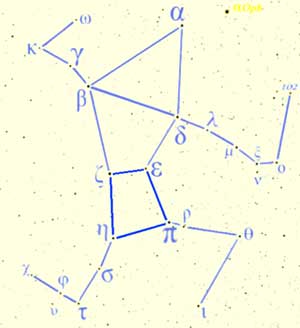 Hercules is one of the most prominent constellations, but its bright stars could shine more. Hercules is a hero from Greek mythology. He is one of Zeus’s children and is said to be very brave. This constellation is an image of Hercules, who became a god after his death.
Hercules is one of the most prominent constellations, but its bright stars could shine more. Hercules is a hero from Greek mythology. He is one of Zeus’s children and is said to be very brave. This constellation is an image of Hercules, who became a god after his death.
Orion
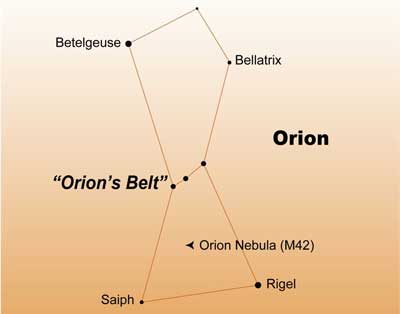
Orion mainly consists of supergiant stars, the largest and brightest stars. Three of these shining stars form a line called Orion’s Belt. They lead to Sirius, which is the brightest star in the sky. Orion can be seen from both the Southern Sky and the Northern Hemisphere.
In Greek mythology, Orion was a giant and an excellent hunter. Zeus placed him among the stars after Orion’s death. Orion looks like he is defending himself from a nearby constellation called „Taurus the bull“. Orion holds a club or weapon and a lion pelt in one hand. This constellation is visible throughout the world.
Pegasus
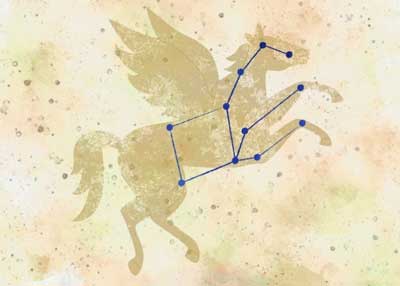 Pegasus is a constellation in the Northern sky. In Greek mythology, Pegasus is a magical horse with wings. One of the stories about Pegasus says that his hooves dug out a spring, and anyone who drank the water was given the gift of writing poetry.
Pegasus is a constellation in the Northern sky. In Greek mythology, Pegasus is a magical horse with wings. One of the stories about Pegasus says that his hooves dug out a spring, and anyone who drank the water was given the gift of writing poetry.
Draco
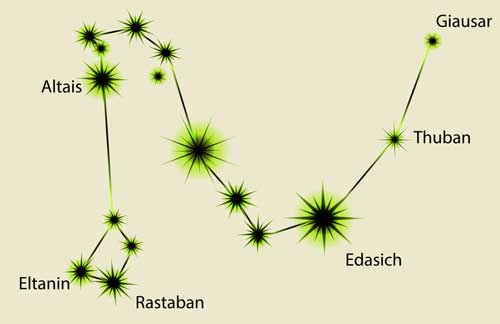
Draco is Latin for Draconem. It means giant serpent or dragon. This constellation looks like a large snake through the Northern sky.
It can be seen all year from the Northern Hemisphere. There are a lot of different myths about Draco. One common myth says that Draco was tasked with guarding some golden apples for Hera, the wife of Zeus. But Hercules slayed Draco to get the apples. Hera was so sad when somebody killed Draco that she placed him in the sky.
Aquarius
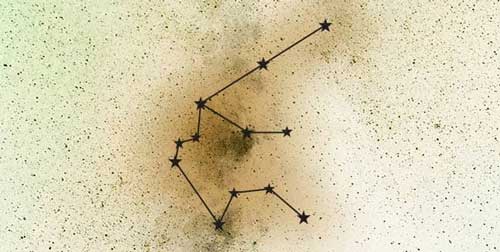 Aquarius is another large constellation with stars that aren’t very bright. It is visible from the Southern or the Northern hemispheres during other months of the year. The myth related to the constellation Aquarius is about a man named Ganymede who lived on Earth. Ganymede was very handsome, and the king of the Gods, Zeus, noticed him. Zeus sent his messenger down to Earth to tell Ganymede to come to Mount Olympus, where the gods lived, and serve the gods by bringing them water. Ganymede obeyed. Zeus thanked Ganymede for his service by putting a constellation of him in the sky. Aquarius means „water carrier“. This constellation shows Ganymede kneeling in the sky, pouring water out of a pitcher.
Aquarius is another large constellation with stars that aren’t very bright. It is visible from the Southern or the Northern hemispheres during other months of the year. The myth related to the constellation Aquarius is about a man named Ganymede who lived on Earth. Ganymede was very handsome, and the king of the Gods, Zeus, noticed him. Zeus sent his messenger down to Earth to tell Ganymede to come to Mount Olympus, where the gods lived, and serve the gods by bringing them water. Ganymede obeyed. Zeus thanked Ganymede for his service by putting a constellation of him in the sky. Aquarius means „water carrier“. This constellation shows Ganymede kneeling in the sky, pouring water out of a pitcher.
Ursa Major
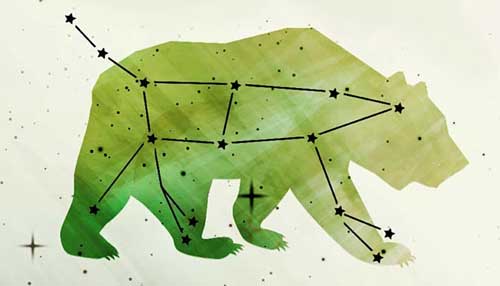 Ursa Major means „great bear“. You have probably heard of a smaller section called „the big dipper“. A big dipper is a group of stars inside Ursa Major. It makes up part of the back half of the bear as well as its tail. The big dipper is not a constellation, as some people think. It is called an asterism, a group of stars smaller than a constellation or part of a constellation. The story of the Great bear is that Zeus turned a beautiful woman named Calisto into a bear to hide her from his wife.
Ursa Major means „great bear“. You have probably heard of a smaller section called „the big dipper“. A big dipper is a group of stars inside Ursa Major. It makes up part of the back half of the bear as well as its tail. The big dipper is not a constellation, as some people think. It is called an asterism, a group of stars smaller than a constellation or part of a constellation. The story of the Great bear is that Zeus turned a beautiful woman named Calisto into a bear to hide her from his wife.
Ursa Minor
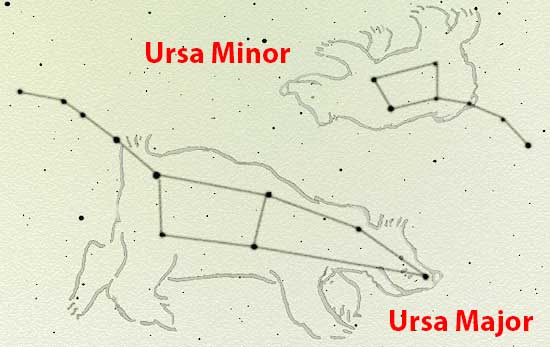 Ursa Minor is also known as „little bear“. Little bear is the child of Great Bear. The little dipper makes up part of Ursa Minor.
Ursa Minor is also known as „little bear“. Little bear is the child of Great Bear. The little dipper makes up part of Ursa Minor.
Zodiac Constellations
You also might have heard of twelve other constellations called the signs of the Zodiac. They represent all the dates in a calendar year. Your birthday determines what your zodiac sign is. Some people believe that the different characters of the Zodiac will tell you what your talents are and your personality is like. The signs might reveal that you are a shy person or outgoing. Or that you are laidback or more serious. Some people also believe the signs can make confident predictions about your life and your future. Here are the locations of the 12 constellations of the Zodiac and their names:
- Aries,
- Taurus,
- Gemini,
- Cancer,
- Leo,
- Virgo,
- Libra,
- Scorpio,
- Sagittarius,
- Capricorn,
- Aquarius and
- Pisces.
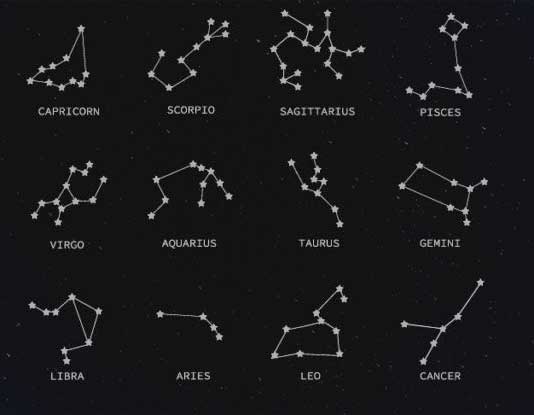
Constellations can be very useful. They helped ancient farmers know when to plant and harvest crops and were used as a type of calendar in the sky. Many travellers relied on different stars, like Polaris or the North star, and various constellations to guide them on their journeys. Modern astronomers and star gazers use constellations to help keep track of specific stars in the sky.
They also locate other objects in the sky, such as galaxies. In 1922, the sky was divided into 88 different constellations, but not all are as well-known as others. Many of the constellations may be seen in the Northern Hemisphere but may not be visible in the Southern Hemisphere. And some may be easier to locate depending on the time of year. The next time you are outside, look up at the stars and see which constellations you can identify.
There are more than 300 billion stars in the Milky Way Galaxy. It also is the galaxy where our solar system is located. Our solar system comprises space rocks, planets, the Sun, the Moon, and Earth.
But did you know that the Milky Way is only one of about 100 billion galaxies? And if we put all those billions of galaxies together, there would be trillions and stars throughout the universe. That’s a lot of stars! Amazingly, out of all those trillions of stars, when you look up at the night sky, you can only see about 4,500 of them. You only see a tiny fraction of how many stars are out there.
What’s remarkable is that each one differs from the trillions of stars.
- Some stars may have their system of planets.
- Some stars are older than others.
- And some stars may no longer exist, but their light still travels toward Earth.
It may seem odd that a star’s light can still be seen after it’s gone, but stars are born, live, and die after some time, just like us. After they die, their light continues to travel throughout the universe. A star might disappear for thousands of years when its light reaches us.
Additional information: What are the 12 most common constellations? * What are the seven significant constellations? * Are there 88 named constellations?
And in the end, see the recommended video:
FAQ
Sure, here are five frequently asked questions about constellations and their answers:
- What is the difference between a constellation and an asterism?
A constellation is a group of stars that form a recognizable pattern or shape. At the same time, an asterism is a smaller group of stars within a constellation that also constitutes a recognizable pattern. For example, the Big Dipper is an asterism within Ursa Major’s constellation.
- Why do constellations have different names in different cultures?
Different cultures have their unique histories, myths, and beliefs that they associate with the stars, and these have been reflected in the naming and interpretation of constellations over time. For example, the Chinese have their own constellations distinct from those recognized by Western astronomers.
- How do I find a specific constellation in the night sky?
The best way to find a specific constellation is to look for a star chart or use a stargazing app to help you identify the stars and patterns in the sky. You can also look for bright stars that are part of the constellation and use them as a guide to finding the rest of the pattern.
- Can you see constellations from the Southern Hemisphere?
Yes, many constellations are visible from both the Northern and Southern Hemispheres, but the view of the night sky will be slightly different depending on where you are located.
- How many constellations are there?
Eighty-eight officially recognized constellations cover the entire sky, but many cultures and societies have identified their unique constellations over time. Additionally, amateur astronomers and stargazers have identified many more unofficial constellations and asterisms.
How Many Constellations are There. Look at the Major 88 of Them!
Conclusion
In conclusion, constellations are a fascinating and intriguing natural world aspect that has captured the human imagination for centuries. There is much to discover in the night sky. Understanding the different types of constellations, their origins, and their connections to zodiac signs can be a great way to begin exploring the cosmos.
If you found this article helpful or informative, we encourage you to share it with others interested in learning more about constellations. Whether on social media or in person, sharing knowledge and insight about the world can be a great way to connect with others and foster a deeper appreciation for the universe’s wonders.

Marta Savova is a journalist, health, technolgy and science writer. With over 20 years of experience in the field, she has published numerous research papers and articles and has a passion for sharing his knowledge with others. He is a regular contributor to several media.
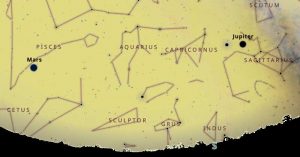

Finally, I think it’s important to emphasize that while constellations are a beautiful and inspiring aspect of the natural world, they are not just a thing of the past. Astronomy and astrophysics are active research fields that constantly expand our understanding of the universe, and constellations play an important role in this work. By studying the patterns of stars and galaxies, scientists can learn about the history and evolution of the cosmos.
I would also like to mention that some constellations are more prominent than others depending on where you are. For example, while the Big Dipper is a well-known asterism in the Northern Hemisphere, it is not visible from the Southern Hemisphere. Similarly, the Southern Cross is a prominent constellation in the Southern Hemisphere that is not visible from the Northern Hemisphere.
While it’s true that many constellations are named after mythological characters, it’s important to remember that these characters often represent archetypes or ideas important to the people who named them. For example, the story of Perseus represents the triumph of good over evil and the power of heroes to overcome adversity. Understanding the symbolic significance of these stories can help deepen our appreciation of the constellations.
I would also like to add that there are different ways to categorize constellations besides those mentioned earlier. For example, some constellations are named after objects. Also, phenomena outside the sky, such as the Microscope, the Compass, or the Telescope. Additionally, some constellations are named after objects or characters from literature or popular culture, such as the Sherlock Holmes constellation or the Mario Brothers constellation.
I think it’s important to note that while the zodiac signs are based on the positions of the Sun relative to certain constellations during specific times of the year, the constellations themselves are not the same as the zodiac signs. It is because of precession. The positions of the stars and constellations shift over time due to the Earth’s wobbling on its axis. As a result, the zodiac signs’ positions have also shifted over time.
The constellation of Scorpius is one of the most recognizable constellations in the southern hemisphere. It is best viewed during the summer months. Scorpius is notable for its bright red star, the great Antares, the 15th brightest shiny star in the night sky. The constellation is also home to several bright stars and interesting and mysterius deep-sky objects, including the open cluster M6 and the globular cluster M80.
The constellation of Ursa Major, we also call it the Great Bear, is one of the oldest known constellations. It is visible worldwide and can be seen in the northern hemisphere during the green spring and yellow summer months. The most notable feature of the great Ursa Major is the group of seven shiny stars that make up the mysterius „Big Dipper“ asterism. These significant stars are bright and easily visible, making Ursa Major a famous constellation for stargazing.
Cassiopeia is another well-recognizable constellation that can be seen in the northern hemisphere. It is best viewed during the fall and winter months. The constellation comprises several bright stars that form a distinctive „W“ shape. Cassiopeia is also notable for being located near the North Star, Polaris, which makes it easy to find in the dark blinking sky.
Orion is one of the most known constellations in the night sky. It is visible worldwide and in the northern hemisphere during the cold winter months. The constellation consists of several bright stars, including Betelgeuse, Rigel, and Bellatrix. The most notable feature of Orion is the three stars that make up the „belt“ of the constellation. These stars are easily visible and are often used as a reference point for other celestial bodies.
The constellation of Cygnus is often referred to as the „Northern Cross“ due to its distinctive shape. It is visible worldwide and in the northern upper hemisphere during the summer months. The most notable feature of Cygnus is the brightest star Deneb, which marks the swan’s tail. The constellation is also home to several other bright shiny stars and deep-sky funny objects, including the famous „North America Nebula“ and the so called „Pelican Nebula.“
If I’m not the inventor of the The Winter Football mega-constellation, I’m certainly it’s strongest advocate and folklorist
No matter how many times John Holley tried to tell me how to find the Southern Cross, I still had trouble. More practice is what I need!!